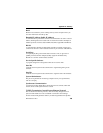
Appendix A: Glossary
RFM-4000-5015 Rev1
105
Differential GPS
A procedure of correcting GPS solutions to achieve improved position
accuracy. Differential GPS provides 2 to 5 meter position accuracy. Differential
accuracy is obtained by applying corrections determined by the stationary
Differential Reference Station to the GPS data collected by the RPU (receiver
processing unit) on-board the vehicle.
DNS
Domain Name Server. This is what converts names of domains (ex. :
www.nextel.com) into IP addresses (ex. : 170.206.225.22). The DNS server
that you use is generally situated with your access provider.
DTE
Data Terminal Equipment. A computer or hand-held device that generates and
receives data, and provides functions that control data communications through
a device like the modem.
Dial Up Networking (DUN)
A component in Windows that enables you to connect your computer to a
network via modem. If your computer is not connected to a LAN and you want
to connect to the Internet, you need to configure Dial-Up-Networking (DUN) to
dial a Point of Presence (POP) and log into your Internet Service Provider
(ISP). Your ISP will need to provide certain information, such as the gateway
address and your computer’s IP address.
Firmware
A set of software computer/processor instructions permanently or semi-
permanently resident in read-only memory.
Frequency
The number of vibrations per second of an audio or radio signal. Measured in
hertz (Hz), Kilohertz (kHz), or megahertz (MHz). GPS frequencies are L1=
1575.42 MHz or L2= 1227.60 MHz.
GPS
(Global Positioning System) is a "constellation" of 24 well-spaced satellites
that orbit the Earth and make it possible for people with ground receivers to
pinpoint their geographic location. The location accuracy is anywhere from 100
to 10 meters for most equipment. Accuracy can be pinpointed to within one (1)
meter with special military-approved equipment. The GPS is owned and


















